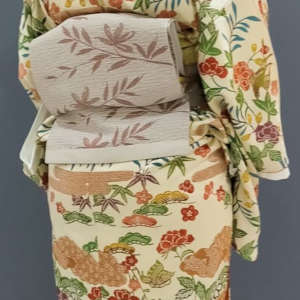Obi
Obi and related accessories online, such as obijime (obi cords) and obiage (obi sashes). They are made in Japan and crafted from silk.Japanese Silk 100%. Made in Japan.
The kimono obi is an essential accessory when wearing traditional Japanese attire known as kimono. Not only does the obi serve the practical function of cinching the kimono at the waist, but it also plays a crucial role in enhancing the overall aesthetic and individuality of the outfit. Below is a detailed explanation of the kimono obi:
1. Material: Obis are crafted from various materials including silk (kinu), polyester, and cotton. Silk obis exude a sense of luxury and are commonly worn for formal occasions or when a high level of sophistication is desired. Polyester or cotton obis, on the other hand, are more practical for everyday wear due to their easy maintenance.
2. Patterns and Designs: Obis feature a wide array of patterns and designs, ranging from traditional motifs such as floral and bird patterns to modern and abstract designs. Seasonal motifs and patterns corresponding to specific events are also prevalent, adding a touch of seasonal flair when paired with the kimono.
3. Length and Width: Obis typically measure between 4 to 6 meters in length and 30 to 40 centimeters in width, although variations exist depending on the type of kimono and tying method.
4. Tying Methods: Tying the obi is a blend of skill and artistry, with numerous tying methods available. Popular tying styles include the “otaiko musubi” (drum knot), “fukura suzume musubi” (puffed sparrow knot), and “mitsu musubi” (three-fold knot). The choice of tying method, as well as the positioning and angle of the obi, significantly influences the overall impression of the kimono.
5. Embellishments: Obis may be adorned with decorative accessories such as metal ornaments or gemstones. These embellishments, known as obijime (cord) and obidome (decorative clasp), add an extra layer of elegance and sophistication to the obi.
6. Usage: Obis are worn on various occasions, ranging from casual wear to formal events. While formal occasions often call for elaborate and luxurious obis, even everyday kimono attire can be enhanced with a well-chosen obi, adding a touch of elegance to the ensemble.
The kimono obi embodies the rich traditions and aesthetic sensibilities of Japanese culture. Through its intricate tying techniques and decorative elements, the obi enhances the beauty and depth of the kimono attire, offering a glimpse into the captivating world of Japanese fashion and craftsmanship.
